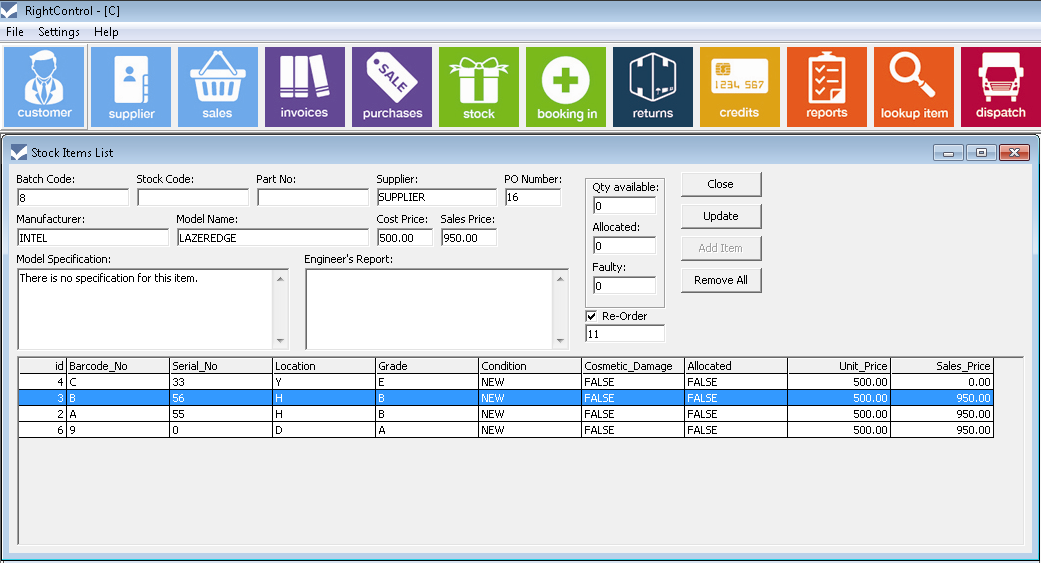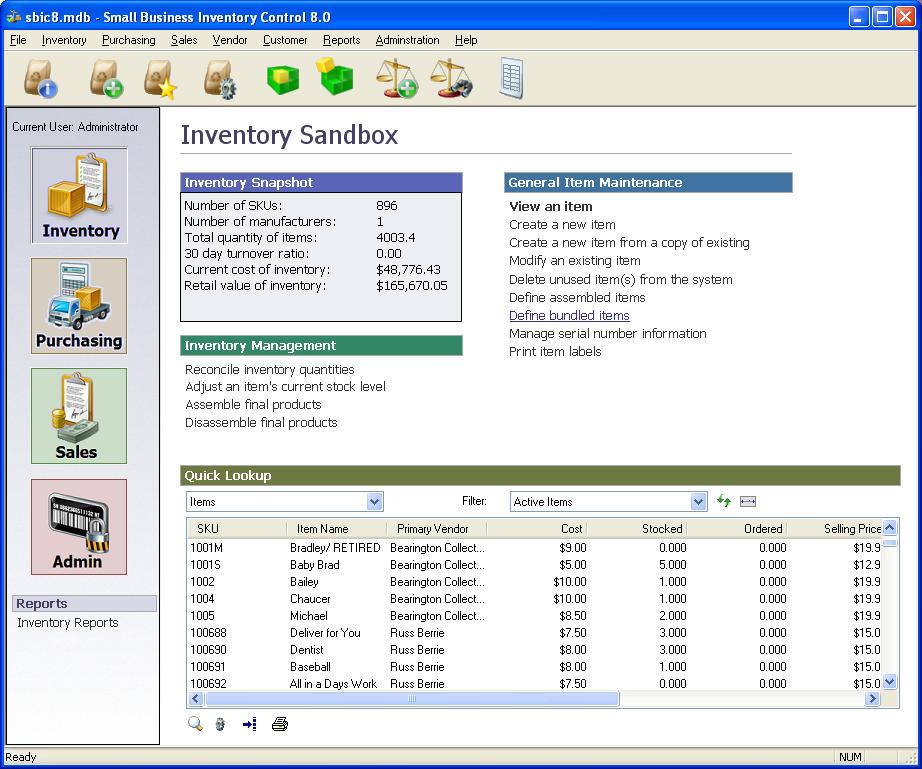Software for business inventory has emerged as a cornerstone of modern inventory management, transforming the way businesses track, manage, and optimize their inventory operations. This software empowers businesses to streamline their inventory processes, enhance accuracy, and gain valuable insights to drive informed decision-making.
With its comprehensive features, businesses can automate inventory tracking, optimize stock levels, and improve order fulfillment, resulting in increased efficiency, reduced costs, and enhanced customer satisfaction.
Software Features for Business Inventory Management: Software For Business Inventory
Inventory management software is essential for businesses of all sizes. It can help you track your inventory levels, manage your orders, and optimize your supply chain. However, not all inventory management software is created equal. Some software solutions offer more features than others, and some features are more important for certain businesses than others.
In this article, we will discuss the essential features of inventory management software and how they can benefit your business. We will also provide a table comparing the features of different software solutions.
Essential Features of Inventory Management Software
- Inventory tracking: This feature allows you to track your inventory levels in real time. You can see how much of each item you have on hand, where it is located, and when it is expected to be received or shipped.
- Order management: This feature allows you to manage your orders from start to finish. You can create orders, track their progress, and update their status.
- Supply chain optimization: This feature helps you optimize your supply chain by identifying inefficiencies and recommending improvements. It can help you reduce your lead times, improve your inventory turnover, and lower your costs.
- Reporting: This feature allows you to generate reports on your inventory levels, orders, and supply chain. These reports can help you identify trends, make informed decisions, and improve your overall performance.
- Integration with other systems: This feature allows you to integrate your inventory management software with other systems, such as your accounting software, your CRM, and your e-commerce platform. This can help you streamline your operations and improve your efficiency.
Types of Software for Business Inventory

Inventory management software plays a vital role in businesses of all sizes. However, with a wide range of options available, choosing the right software for your specific needs can be challenging. Here are the different types of software available for business inventory management:
On-Premise Software
On-premise software is installed on a company’s own servers and managed in-house. This type of software offers greater control over data security and customization, but it also requires a significant investment in hardware and IT resources.
Advantages:
- Greater control over data security and customization
- Improved performance and reliability
- Lower ongoing costs after the initial investment
Disadvantages:
- High upfront costs for hardware and IT resources
- Requires dedicated IT staff for maintenance and updates
- Limited accessibility outside of the company’s network
Examples:
- Microsoft Dynamics NAV
- SAP Business One
- Oracle NetSuite
Cloud-Based Software
Cloud-based software is hosted on remote servers and accessed via the internet. This type of software offers flexibility, scalability, and lower upfront costs, but it may have limitations in terms of data security and customization.
Advantages:
- Lower upfront costs and no need for hardware investment
- Increased flexibility and accessibility from anywhere with an internet connection
- Automatic updates and maintenance by the vendor
Disadvantages:
- Limited control over data security and customization
- Potential performance issues during peak usage
- Ongoing subscription costs
Examples:
- Shopify
- Zoho Inventory
- QuickBooks Online
Mobile-First Software
Mobile-first software is designed specifically for use on smartphones and tablets. This type of software offers convenience and flexibility for businesses that manage inventory on the go.
Advantages:
- Increased accessibility and convenience for mobile workers
- Improved efficiency and productivity in inventory management
- Enhanced collaboration and communication
Disadvantages:
- Limited functionality compared to desktop or cloud-based software
- Potential security risks associated with mobile devices
- May require additional hardware investment for mobile devices
Examples:
- ScanSKU
- InFlow Inventory
- Stock & Inventory Manager
Implementation and Integration of Inventory Software
Integrating inventory software into a business can streamline operations, reduce costs, and improve efficiency. Here are the key steps involved:
Selecting the Right Software: Choose software that aligns with your business needs, such as industry-specific features, scalability, and integration capabilities.
Customization: Configure the software to match your specific processes, including defining inventory categories, setting reorder points, and establishing workflows.
Data Import: Import existing inventory data into the software to create a comprehensive inventory record.
Integration: Connect the inventory software with other business systems, such as accounting, sales, and purchasing, to automate data exchange and eliminate manual errors.
Training: Train staff on the new software to ensure proper usage and maximize its benefits.
Best Practices for Integration
- Use APIs: Leverage application programming interfaces (APIs) to facilitate seamless data transfer between systems.
- Establish Clear Data Standards: Define consistent data formats and mapping rules to ensure accurate data exchange.
- Test Integrations Thoroughly: Conduct thorough testing to verify the accuracy and reliability of data transfer.
- Monitor Integration Regularly: Regularly monitor integrations to identify and resolve any issues promptly.
Benefits of Using Inventory Software

Inventory management software offers numerous advantages for businesses of all sizes, streamlining operations, reducing costs, and improving efficiency. Here are some key benefits:
Enhanced Inventory Accuracy
- Real-time updates and automated tracking minimize human error and discrepancies.
- Businesses can maintain accurate stock levels, reducing the risk of overstocking or understocking.
- Improved inventory visibility allows for timely replenishment and prevents stockouts.
Reduced Costs
- Software automates inventory processes, reducing labor costs and the need for manual data entry.
- Accurate inventory levels help businesses optimize purchasing, minimizing overspending and waste.
- Reduced inventory carrying costs through better management and forecasting.
Improved Efficiency
- Automated inventory tracking saves time and resources, freeing up staff for other tasks.
- Streamlined inventory management processes improve order fulfillment and reduce lead times.
- Real-time data availability enables informed decision-making and better planning.
Enhanced Customer Service
- Accurate inventory information ensures that customers can receive accurate delivery estimates.
- Improved stock visibility helps businesses avoid backorders and meet customer expectations.
- Software can provide self-service options for customers to track their orders and check stock availability.
Improved Forecasting and Planning
- Historical data and demand analysis help businesses forecast future demand more accurately.
- Software can generate reports and insights to identify trends and make informed purchasing decisions.
- Improved forecasting reduces the risk of stockouts and overstocking, optimizing inventory levels.
Challenges of Implementing Inventory Software

Implementing inventory software can bring significant benefits, but it also comes with potential challenges. These challenges can arise from various factors, including the complexity of the software, integration with existing systems, and resistance to change.
One common challenge is the complexity of inventory software. Businesses may struggle to understand the software’s features and functionality, leading to difficulties in implementation and ongoing use. To overcome this, businesses should choose software that is tailored to their specific needs and provides comprehensive training and support.
Another challenge is integrating inventory software with existing systems. Businesses may need to integrate the software with their accounting, ERP, or other business applications. This integration can be complex and time-consuming, requiring careful planning and technical expertise. To address this, businesses should work closely with software vendors and IT professionals to ensure a smooth integration process.
Resistance to change is also a common challenge. Employees may be reluctant to adopt new software, fearing it will disrupt their workflows or require additional effort. To overcome this, businesses should involve employees in the implementation process, providing clear communication and training to minimize disruptions and gain buy-in.
Overcoming Implementation Challenges
Businesses can overcome these challenges by taking a strategic approach to implementation. This includes:
– Choosing software that is tailored to their specific needs and industry requirements.
– Providing comprehensive training and support to ensure employees are comfortable using the software.
– Integrating the software with existing systems carefully, working closely with software vendors and IT professionals.
– Involving employees in the implementation process, addressing their concerns and providing clear communication.
– Monitoring the implementation progress and making adjustments as needed.
By following these strategies, businesses can successfully implement inventory software and reap its benefits, improving inventory management, reducing costs, and increasing efficiency.
Case Study: Successful Implementation, Software for business inventory
Company XYZ, a large manufacturing firm, faced challenges in managing its inventory across multiple warehouses. They implemented inventory software that integrated with their ERP system, providing real-time visibility into inventory levels. The software also automated inventory replenishment, reducing manual processes and improving efficiency. By successfully overcoming implementation challenges, Company XYZ improved inventory accuracy, reduced lead times, and increased customer satisfaction.
Future Trends in Inventory Software
Inventory software is constantly evolving to meet the changing needs of businesses. Emerging trends and innovations are shaping the future of inventory management, offering new opportunities for businesses to improve efficiency, reduce costs, and gain a competitive edge.
Artificial Intelligence and Machine Learning
Artificial intelligence (AI) and machine learning (ML) are revolutionizing inventory management. AI-powered software can automate tasks such as demand forecasting, inventory optimization, and replenishment planning. ML algorithms can analyze historical data to identify patterns and trends, enabling businesses to make more informed decisions about their inventory levels.
Blockchain Technology
Blockchain technology is a distributed ledger system that provides a secure and transparent way to track inventory transactions. Blockchain-based inventory software can help businesses improve traceability, reduce fraud, and enhance collaboration with suppliers and customers.
Cloud-Based Solutions
Cloud-based inventory software offers several advantages, including scalability, accessibility, and cost-effectiveness. Businesses can access their inventory data from anywhere with an internet connection, making it easier to manage inventory across multiple locations and collaborate with remote teams.
Real-Time Tracking and Visibility
Real-time tracking and visibility are becoming increasingly important in inventory management. IoT devices and sensors can be used to track inventory levels in real time, providing businesses with up-to-date information on the location and status of their assets. This data can be used to optimize inventory levels, reduce shrinkage, and improve customer service.
Predictive Analytics
Predictive analytics can help businesses forecast future demand and optimize their inventory levels accordingly. By analyzing historical data and using ML algorithms, businesses can identify trends and patterns that can help them make more accurate predictions about future demand. This information can be used to reduce overstocking, improve inventory turnover, and avoid stockouts.
Final Conclusion
In conclusion, software for business inventory has revolutionized inventory management practices, providing businesses with a powerful tool to streamline operations, enhance accuracy, and optimize stock levels. By embracing the latest trends and innovations in inventory software, businesses can gain a competitive edge and position themselves for success in the dynamic business landscape.
Helpful Answers
What are the key benefits of using software for business inventory?
Software for business inventory offers numerous benefits, including automated inventory tracking, improved stock accuracy, optimized order fulfillment, reduced costs, and enhanced customer satisfaction.
What types of software are available for business inventory management?
There are various types of software available for business inventory management, including cloud-based software, on-premise software, and mobile applications. Each type offers unique advantages and can be tailored to specific business needs.
How can businesses overcome challenges when implementing inventory software?
Businesses can overcome challenges when implementing inventory software by carefully planning, selecting the right software solution, and ensuring proper training for staff. Additionally, seeking support from vendors or consultants can provide valuable guidance throughout the implementation process.